-
Latham Hi‑Tech Seeds
#AskTheAgronomist: Fungicide & Insecticide Application Thresholds
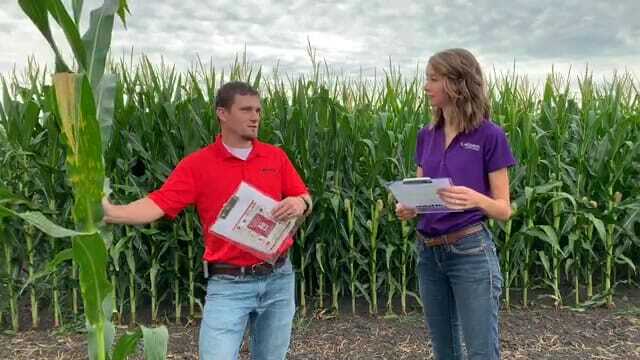 What is the threshold for applying fungicide on your corn? Tune in for discussion on mid-season fungicide and insecticide application with Phil Long! #AskTheAgronomist
What is the threshold for applying fungicide on your corn? Tune in for discussion on mid-season fungicide and insecticide application with Phil Long! #AskTheAgronomist -
Latham Hi‑Tech Seeds
Mid-Season Foliar Fungicide Application
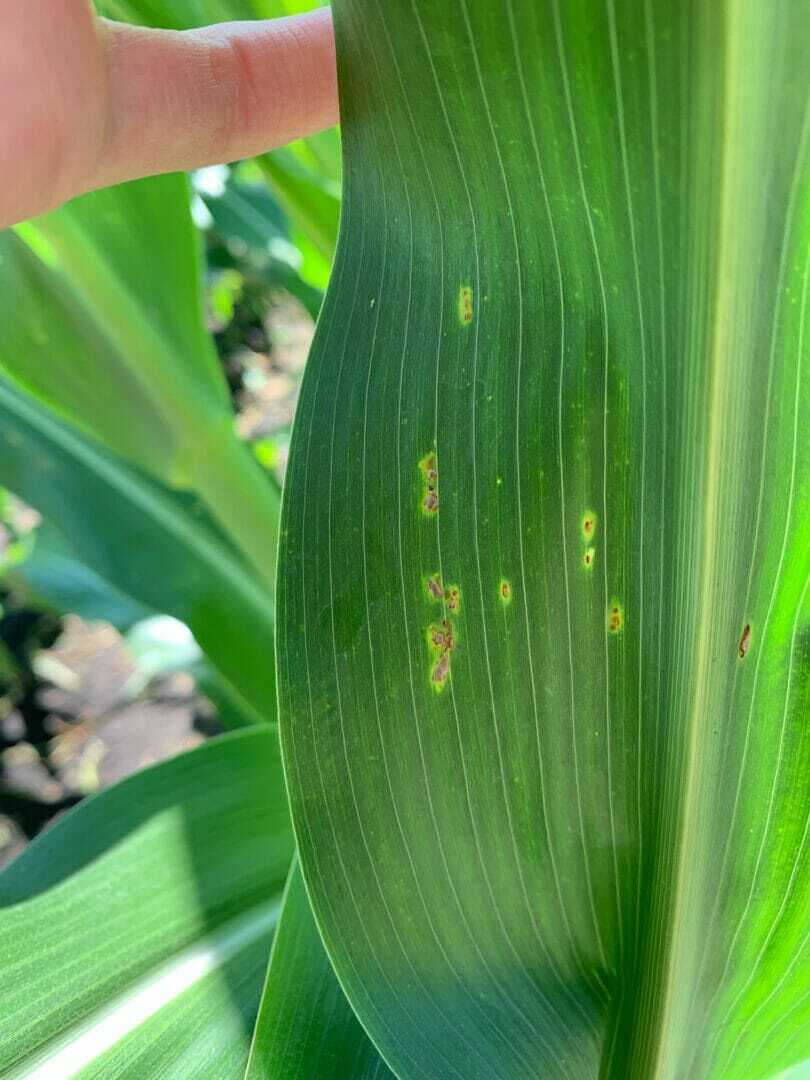
With the hot, humid weather that has made its way into Latham Country this summer, conditions are prime for foliar diseases. Fields considered to be high risk are continuous corn fields, fields with conservation tillage and susceptible hybrids. Watch for Gray Leaf Spot, Southern Rust, Common Rust, Northern Leaf Blight, Goss’s Wilt, Tarspot and Eyespot.
When it comes to weighing the costs and benefits of fungicide, there are many factors to consider. Price of corn, product, application and drying cost can all seem like daunting costs that would scare any farmer away from going the extra mile. However, investing in a fungicide could be a small tradeoff when it comes to protecting your yield potential. When scouting, look for disease on the third leaf below the ear. If 50 percent or more of the field is infected at tassel, we recommend spraying fungicide.
The highest return on investment is going to be around VT to R2 time period because you will be able to suppress diseases that may be present on the leaves and protect them for a few weeks of any diseases trying to get into the plant. Corn is also done putting on new leaves at this point. Typically, a 5-8 bu/A yield increase will pay for the investment depending on grain price and application costs. If you are facing heavy disease pressure, be sure to select the right fungicide for the diseases you have. Fungicides with dual modes of action in the Group 3 (Triazoles) and 11 (QoI) will provide suppression and some lasting protection. Look for the active ingredients that end in “ole” (Triozoles) and “in” (QoI).
We recommend doing your homework before applying fungicide. Scout fields to determine disease pressure, consider high susceptibility hybrids and the disease history of the field.
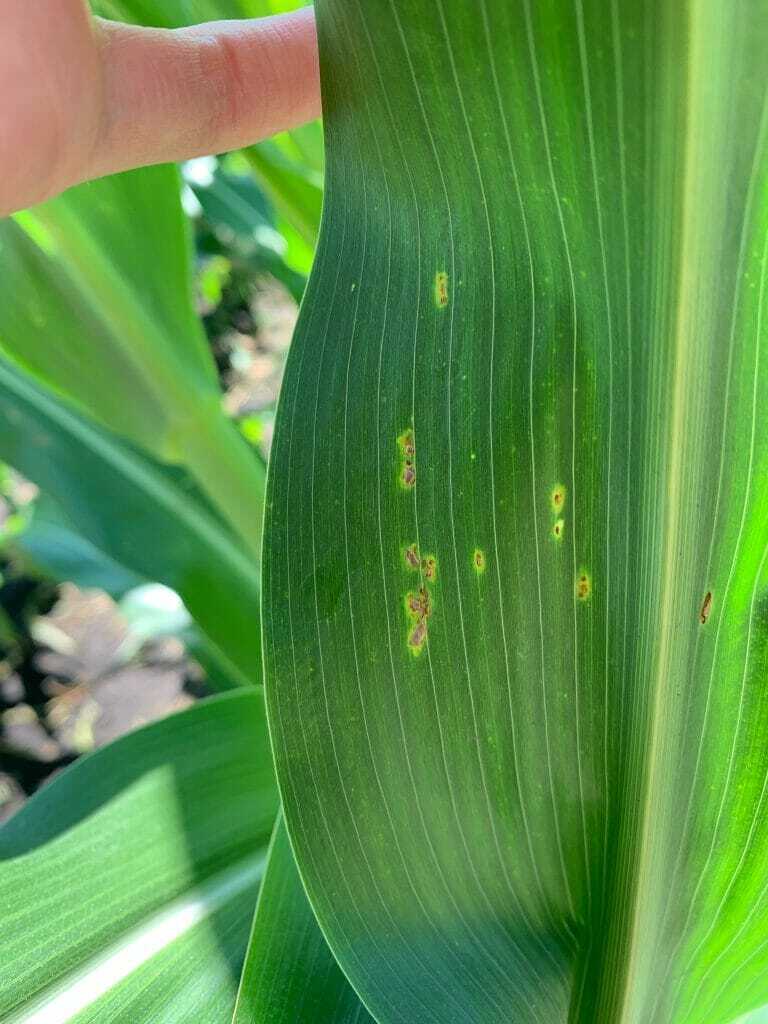
Shown above is common rust. To identify this in your fields, look for raised, brick-red pustules. -
Latham Hi‑Tech Seeds
Early Season Fungicides
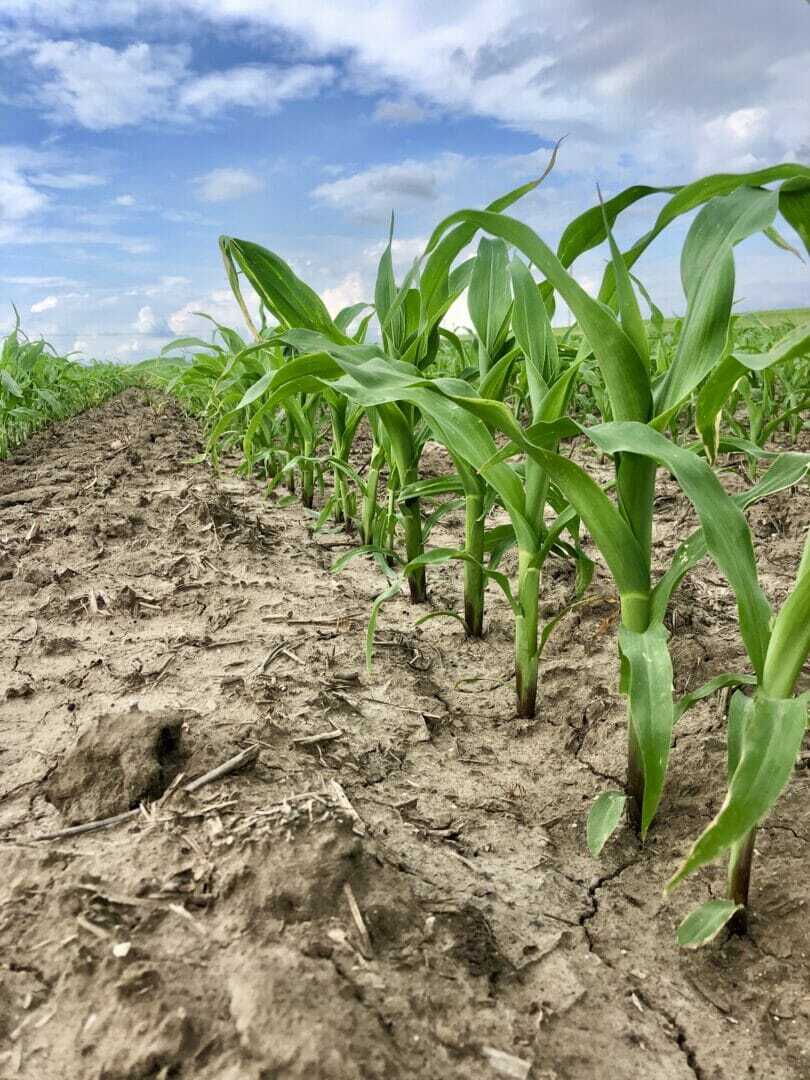
This year we have seen slow early growth, reduced tillage, persistent rain and heavy storms. We have also seen an increase in corn-on-corn acres and other agronomic challenges. All these problems can add up to more inoculum in the field and poor overall health leaving plants more susceptible to infection. The early season diseases we think about with corn are typically Anthracnose and seedling diseases (V2-V8); however, Gray Leaf Spot, Northern Corn Leaf Blight, Goss’s Wilt, Southern Rust and Tar Spot can all show early foliar symptoms (V8-R4). Its important to note that bacterial diseases like Goss’s can’t be controlled with a fungicide.
There is very little economic support for early season fungicide application. Depending on the individual fungicide, you may see protection against disease for anywhere from 7 to 21 days. Be sure to check the label for specifics on how long they retain efficacy on the crop. If your focus is on Anthracnose, you may stave off the leaf blight phase of the disease, but this doesn’t mean that the stalk rot phase of the disease won’t infect the plant late season.
It’s also important to remember that coverage is critical with fungicides. This not only means good coverage during your spray operation with correction nozzles, pressure and volume, but it also means that if you spray early in the season, your corn will grow a new leaf approximately every 3-5 days with average GDUs. That new tissue is not protected because fungicides are not very mobile in the plant.
When to Spray?
The best bang for your buck is still going to be around VT to R2 time period because you will be able to suppress diseases that may be present on the leaves and protect them for a few weeks of any diseases trying to get into the plant. Corn is also done putting on new leaves at this point. Typically a 5-8 bu/A yield increase will pay for the investment depending on grain price and application costs. If you are facing heavy disease pressure, be sure to select the right fungicide for the diseases you have. Fungicides with dual modes of action in the Group 3 (Triazoles) and 11 (QoI) will provide suppression and some lasting protection. Look for the active ingredients that end in “ole” (Triozoles) and “in” (QoI).
If you’re facing the fungicide decision to protect valuable yield in a tough year scout your fields for disease. If you don’t see any issues now, then skip an early application and focus on tassel. Take a look at the susceptibility of that hybrid to the disease you are seeing and then evaluate the weather outlook and if you’re in a corn-on-corn or reduced tillage situation. Lastly, monitor fields closely that had Tar Spot last season
It has been an interesting year with all the weather components we have had to face. If you have any questions, don’t hesitate to call in to the Latham Office.
-
Latham Hi‑Tech Seeds
Phytophthora Root and Stem Rot – “Damping Off”
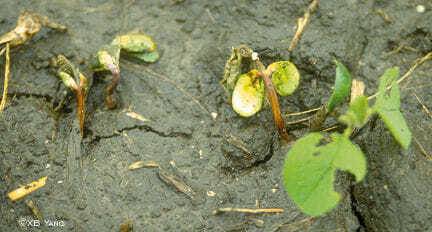
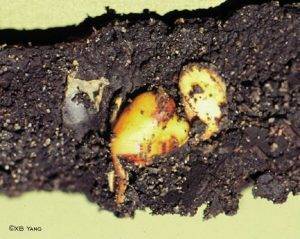 Rotting of soybean stem and root tissue, or “damping off,” can jeopardize stand quality and reduce yield. The Phytophthora fungi can impact seedlings both before and after emergence. Even if seedlings successfully emerge above the soil, they will have poor vigor and slow early growth.
Rotting of soybean stem and root tissue, or “damping off,” can jeopardize stand quality and reduce yield. The Phytophthora fungi can impact seedlings both before and after emergence. Even if seedlings successfully emerge above the soil, they will have poor vigor and slow early growth.Poor stand is one of the primary consequences of damping off, though replanting may be possible. North Dakota State University research cites that Phytophthora-related yield loss has reached up to 30% in states throughout the Midwest.
Cool weather is a major cause of damping off as it slows germination and stifles growth. Phytophthora thrives in soil temperatures between 70 and 77°F but can also survive in extremely cold temperatures. Warm temperatures, poor drainage and/or clay soils create a susceptible environment for damping off.
Scouting for Phytophthora
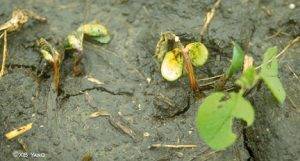 Before seedlings emerge, the fungi can cause seeds to rot. Rotten seeds will appear to be caked in soil with discolored roots. Roots may not be fully developed or even exist.
Before seedlings emerge, the fungi can cause seeds to rot. Rotten seeds will appear to be caked in soil with discolored roots. Roots may not be fully developed or even exist.Wilting can occur in emerged seedlings as the cotyledons will appear brown and saturated. Plants that developed leaves before showing signs of damping off will begin to turn a grayish color before turning brown.
Treatment
Damping off can sometimes be confused with herbicide injury. Whereas fields impacted by herbicide injury will have uniform damage, damping off will create inconsistent patches of impacted crops.
With the overwintering nature of the Phytophthora fungi, controlling the amount of field residue can make the environment less conducive for fungal growth. Also, when planting early or in fields with poor drainage consider using fungicide seed treatments to protect seedlings.
Varieties equipped with genes resistant to Phytophthora will protect plants after they emerge and later in the season as well. Contact your local Latham® representative to determine which varieties will work best for your needs.
-
Latham Hi‑Tech Seeds
FB Live: Fungicide Application
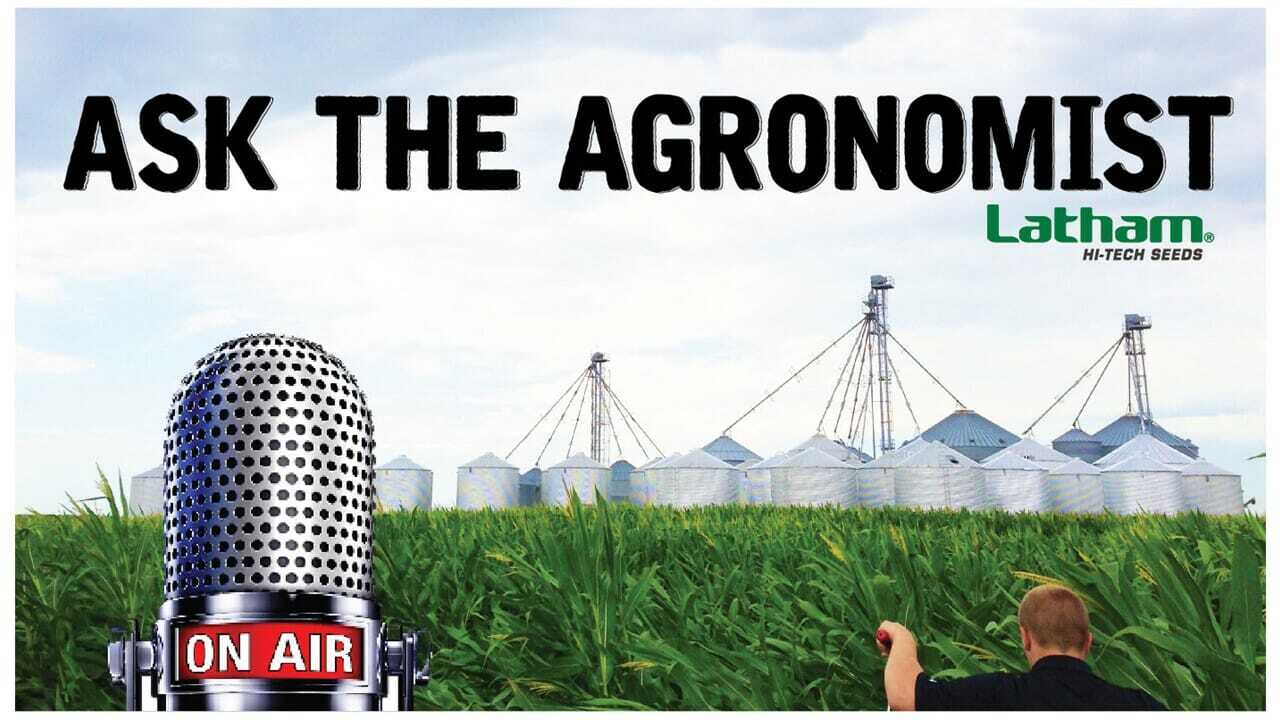
Tune in for live discussion with Phil Long on fungicide application tips and factors to consider when planning for your 2019 crop year.
FB Live Video: https://www.facebook.com/LathamSeeds/videos/10156586918247138/
-
Latham Hi‑Tech Seeds
Foliar Fungicides: Are they worth it?
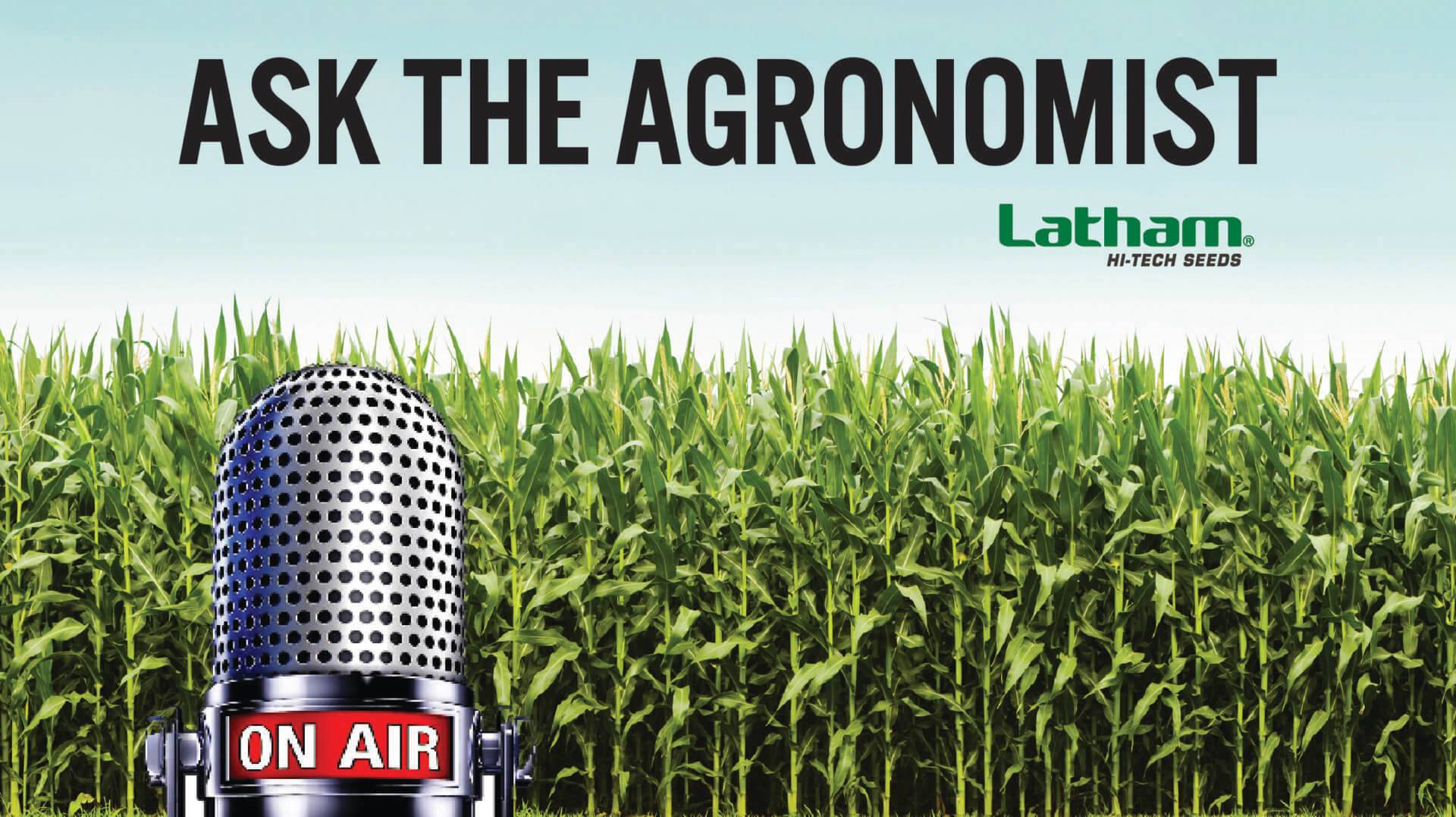
Foliar Fungicides: Are They Worth It?
With the hot, humid weather that has made its way into Latham Country this week, conditions are prime for foliar diseases. Scout fields prior to tassel to determine disease pressure. Fields considered to be high risk are continuous corn fields, fields with conservation tillage and susceptible hybrids.
Watch for Gray Leaf Spot, Southern Rust, Common Rust, Northern and Southern Leaf Blight and Eyespot. Northern Leaf Blight has already been confirmed in southern Wisconsin, and nearly a month earlier than last year.
Q: How do I know when it is most beneficial to apply a foliar fungicide?
A: Prior to tasseling. Some research shows that application prior to the V8 stage is beneficial, but to do that, disease pressure and identification is key to timing of application. In soybeans, the best time to apply is between R1 (flowering) and R3.
If you are concerned about foliar disease after heavy rainfall or hail, fungicide should be applied depending on the upcoming weather forecast and the weather prior to damage. Most labels suggest applying within 72 hours after the weather event to get the best efficacy out of the fungicide. It is crucial to read and follow the label as each fungicide has its own personality.
Q: Are there benefits of fungicide outside of crop protection?
A: Fungicide that is applied at the proper time can produce positive results in the form of saved yield for corn and soybeans. While some studies have shown an increase in performance that can’t be attributed to saving yield due to decreased diseases, these results have been inconsistent and more work needs to be done in this area. U.S. agriculture is going through a period where commodity prices are low and return on investment is minimal. We would encourage farmers in Latham Country to at least consider conducting their own trials to see the benefits of foliar fungicides in their operations.
When it comes to weighing the costs and benefits of fungicide, there are many factors to consider. Price of corn, product, application and drying costs can all seem like daunting costs that would scare away any farmer from going the extra mile. However, investing in fungicide could be a small tradeoff when it comes to protecting your yield.
If you have a question about what you’re seeing in the fields, feel free to ask! Send your questions via Twitter to @LathamSeeds, in a private message on Facebook or call our office at 1-877-GO-LATHAM (1.877.465.2842).
-
Latham Hi‑Tech Seeds
Stress Increases Pressure from Pests and Pathogens
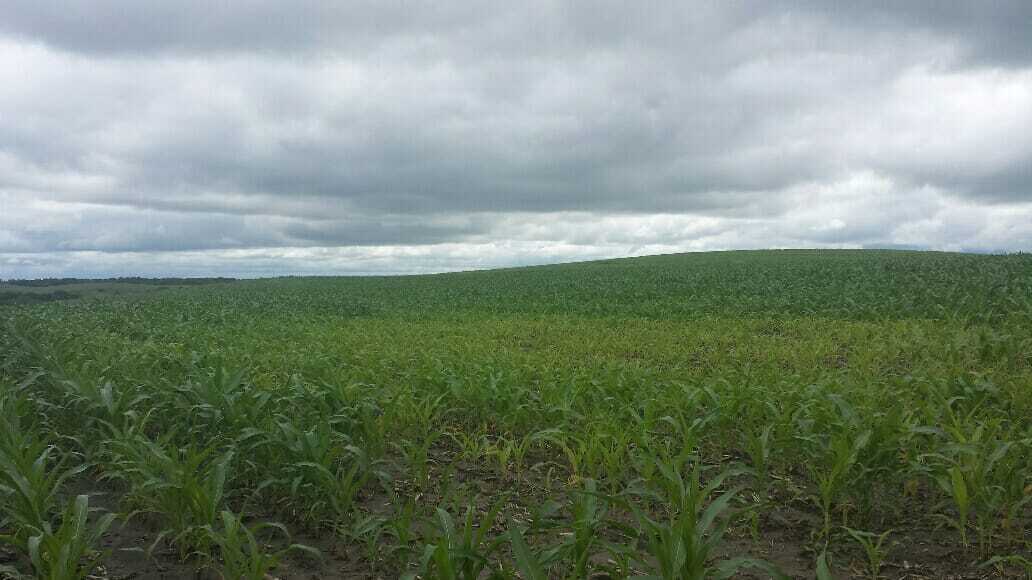
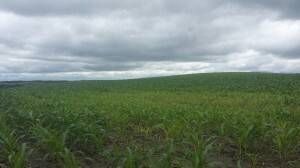 Scouting was going to be critical throughout the growing season, even if we hadn’t received record-setting rains or devastating natural events including tornadoes and flooding. That’s because seed corn planted into wet soils is prone to problems throughout the growing season such as: stunted plant growth; slow infiltration of water and/or ponding; high surface runoff; poor root system development, or rootless corn; and even nutrient deficiency.
Scouting was going to be critical throughout the growing season, even if we hadn’t received record-setting rains or devastating natural events including tornadoes and flooding. That’s because seed corn planted into wet soils is prone to problems throughout the growing season such as: stunted plant growth; slow infiltration of water and/or ponding; high surface runoff; poor root system development, or rootless corn; and even nutrient deficiency.Recent rain events “add insult to injury” because plants that are stressed are more susceptible to additional injury from pests and pathogens. Lengthy periods of wet soils increase the likelihood of blight and disease like Crazy Top and Goss’ Wilt.
Warm, moist soils also are great breeding grounds for weeds. Crops have a better chance of reaching optimal yield when they’re not competing with weeds for sunlight, water and nutrients. The best management practice for achieving weed control is still a diversity of tactics: cultural, mechanical and herbicide. Research shows that weeds represent the most important and economic damaging pest that Iowa corn and soybean farmers face every year!
-
Latham Hi‑Tech Seeds
Watch for these Pests in 2014
There’s a lot of behind-the-scenes work that goes into producing a crop. You take time to choose the right seed products; then wait for fit planting conditions; and do your best to protect yield throughout the growing season. With planting season nearing, today we’d like to remind Midwest farmers to keep an eye out for these yield-robbing pests:
- Pythium is a soil-borne fungus present in almost every field in the Upper Midwest. It can cause early-season seed decay and seedling blight in both corn and soybean. There are many species of Pythium. Most favor cool, wet conditions at planting and are often associated with low-lying portions of the field. Good seedbed preparation and the use of a seed-applied fungicide like Latham® SoyShieldTM are the best management tools. At our Latham Research Farm in 2014, we will be conducting trials using a new fungicide component that looks very promising against Pythium spp.
- Anthracnose Leaf Blight was noticed last year in fields where corn was planted following corn. It rarely shows up in corn following soybeans. This fungus can survive up to 10 months in crop residue. It’s dispersed by early-season rains when spores, present on the soil surface, splash onto the lower leaves of young corn plants and cause infection. Most foliar-applied fungicides do a good job controlling this disease.
- Brown Spot is a disease that can affect soybeans at an early stage of development. It’s usually found on the lower plant leaves and severity increases with excess moisture in the canopy. Infected leaves turn yellow and drop off the plant. While Brown Spot rarely causes enough damage to warrant a fungicide application by itself; the combination of this disease and other fungal pathogens needs to be considered before using a foliar fungicide.
- Bacterial Blight symptoms were very common in 2013 and should be on every soybean farmers “watch list” for 2014. This bacteria infects soybean plants through bruised or damaged areas of the plant caused by wind, rain, hail or other means. Reddish-brown lesions with water-soaked margins will appear on the upper leaves of a soybean plant. Eventually, these lesions produce large dead areas causing a torn or tattered appearance. Bacterial Blight is not a fungus, therefore foliar fungicides have no effect on this disease.
- Bean Leaf Beetles and Corn Rootworm eggs may be affected by extreme cold weather especially if there is little or no snow cover. A reduction in insect pests would be a silver lining to the harsh winter we just experienced! Keep in mind, best management practices for Corn Rootworm include using multiple tools: rotation, rootworm-traited seed, insecticides at planting to kill the larvae, as well as insecticides later to kill adult beetles.
It appears our spring planting will be delayed. As eager as we all are to get into the field, remember that soils are not truly fit to work or to plant unless you can make a ball of soil, toss it into the air and have it fall apart when it hits the ground. “Have a ball” this planting season!
-
Latham Hi‑Tech Seeds
Evaluating Foliar Fungicide on Soybeans
Many Midwest farmers are asking questions about the benefits of spraying foliar fungicides on their soybean fields. The simple truth is… there are a lot of opinions.
Be very leery when they are bombarded by claims of yield increases due to improved overall plant health. Do some of your own testing before deciding to make large-scale applications of these products. It may very well prove that fungicides of this type will pay great dividends on certain farms and pay zero dividends on others!
There is one very important thing to remember when conducting trials of this kind: leave some areas in the field unsprayed to “check” the actual value of the products. As you make plans for the 2014 crop, keep these three things in mind:
- Be sure you’re making an apples-to-apples comparison. For example, I’ve received reports from farmers who advocate the use of foliar fungicides on soybeans. However, the fields they compared were several miles away and some were not even the same soybean variety!
- There are people out there who want to sell you something, regardless of whether you need it.
- If it sounds too good to be true, it usually is.
One of our brand promises at Latham Hi‑Tech Seeds is to help farmers save time. Another promise is to help farmers reduce risk. That’s why I’m being as honest as possible by questioning the investment in foliar fungicide on soybeans. Seed treatments, on the other hand, are worth the investment. Seed treatments are one key to achieving higher soybean yields; click here for others.
-
Latham Hi‑Tech Seeds
Tips for Late-Season Scouting
Detecting late season corn diseases ASAP will help you prioritize fields for harvest. Hybrid maturity and crop residue management should take a backseat to weak stalks. Start by harvesting fields with the weakest stalk to help preserve the quality and quantity of grain that goes into your hopper.
At this time of year, the biggest concerns are stalk rots or fusarium. Warm, moist weather with extended periods of overcast skies and high humidity makes conditions ideal for stalk rot. Later in the season, you might see stalks break or bend below the ear.
Walk fields now and note what you believe is the cause of stalk rot or lodging: fertility, hail, high wind, amount of rainfall, or the genetic predisposition of a hybrid. The cause of stalk rot could affect the seed you purchase or your management practices in 2014. There’s no better time than the present to plan your next crop! Get your seed ordered while the availabilities of all products are at their highest.
